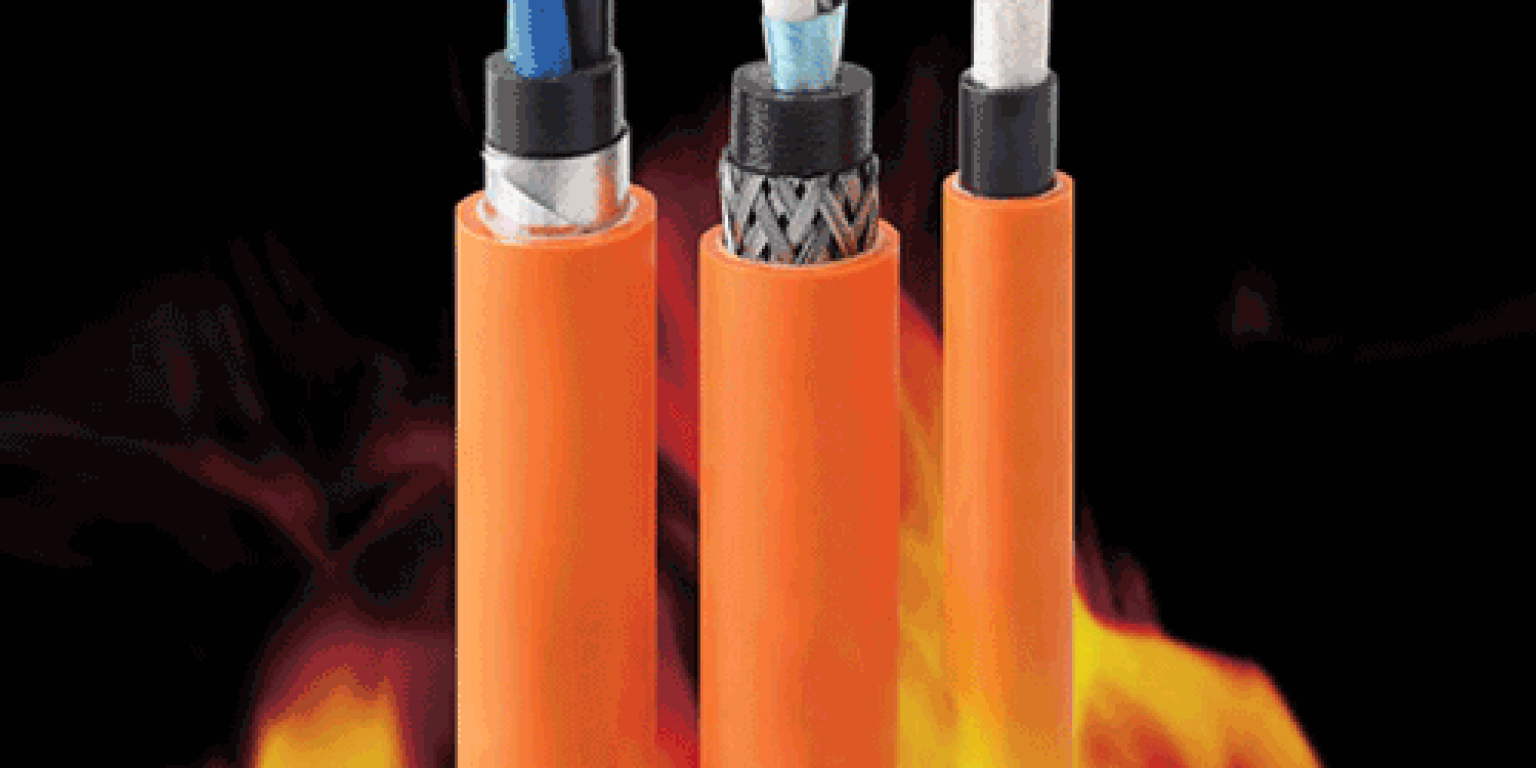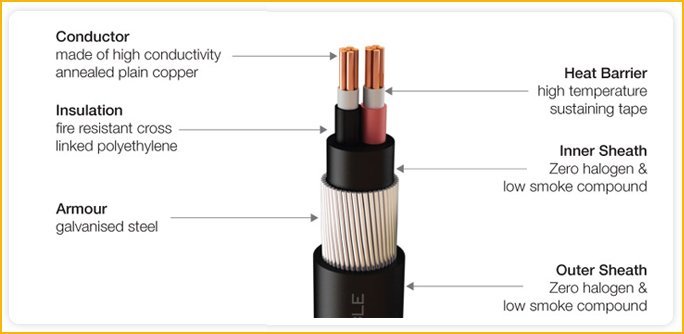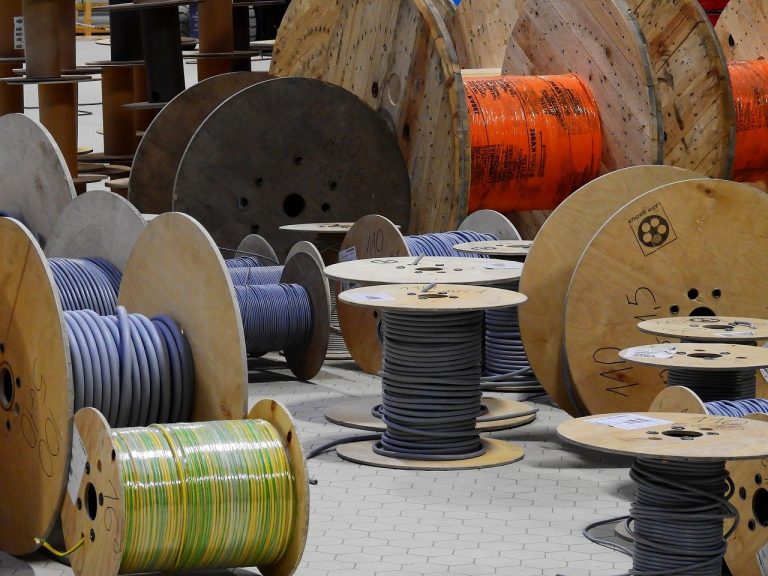A Fire-resistant cable is a cable that can maintain safe operation for a certain period under flame-burning conditions. Fire-resistant wires are widely used in high-rise buildings, subways, underground shopping malls, power stations, and important industrial and mining enterprises related to fire safety and fire rescue。 For example, power supply wires and control wires for fire fighting facilities.
1.What is Fire Resistant Cable?
Fire-resistant cable is divided into class A and class B. Class B cable can be in 750 ℃ ~ 800 ℃ flame and rated voltage to withstand burning for at least 90min, and the cable is not broken. In the refractory layer to improve the manufacturing process and increase the refractory layer and other methods based on Class A fire rated cable development, it can be 950 ℃ ~ 1 000 ℃ flame and rated voltage to withstand burning for at least 90min and the cable is not punctured. Class A fire-resistant cable fire performance is better than class B. Also, mineral insulated cable is a better performance of fire-resistant cables made of copper core, copper sheath, magnesium oxide insulation material processing, referred to as MI (mineral insulated cables) cable. MI cable has good fire resistance characteristics and can work for a long time under 250 ℃ high temperature, but also explosion-proof, strong corrosion-resistance, high flow rate, radiation resistance MI cable has the characteristics of explosion-proof, high corrosion resistance, high current carrying capacity, radiation resistance, high mechanical strength, small size, lightweight, long life, and smokeless. However, the price is high. The process is complicated, the construction is difficult in the oil irrigation area, important wooden public buildings, high-temperature places, and other fire-resistant requirements, and the economy can accept the occasion and use fire-resistant cable.
2.Fire Resistant Cable Specification
The maximum long-term working temperature of the cable
(1) Resistant vinyl polyfluoroethylene insulation and sheath: 70℃ and 105℃ both kinds; Cross-linked polyethene insulation: 90℃.
(2) Fluoroplastic insulation and sheathing: 220℃ and 260℃ two kinds; Fluoroplastic insulation and 105℃ flame retardant polyvinyl fluoride sheathing: 90℃ and 125℃ two kinds.
(3) Low-halogen, low-smoke flame-retardant PVC insulation, and sheathing: 70℃; Halogen-free, low-smoke flame-retardant polyolefin insulation and sheathing: 90℃ and 125℃ both.
Minimum ambient temperature.
(1) Flame retardant PVC insulation and sheathing: fixed laying -40℃; non-fixed laying -15℃.
(2) Fluorine plastic insulation and sheathing: fixed laying -60℃; non-fixed laying -20℃.
The safe laying temperature of the cable should not be lower than 0℃.
Fire resistance characteristics.
Flame temperature 950℃-1000℃ Flame temperature 750℃-800℃
Burning time 90min (recommended) Burning time 90min (recommended)
Additional voltage Rated voltage (min. 100V) Rated voltage (min. 100V)
Fire resistance class A (Class IA~Class IVA) Class I~IV
3. Fire Resistant Cable vs Flame Retardant
Fire-resistant wires are a general term for wire and cable with fire performance, usually divided into the flame retardant wire and cable and fire-resistant wire and cable. It is easy for the general public to confuse flame retardant cables and IEC 60331 fire resistant cable.
However, flame retardant cables have many advantages that are more applicable to chemical companies, such as low halogen, low smoke flame retardant, etc. In general, fire rate power cables can replace flame retardant cables, while flame retardant cables cannot replace fire resistant cables. The following is a brief introduction to their differences and features by ZW Cable.
Fire-resistant cable and flame retardant cable are not the same. The Halogen-containing cable flame retardant principle is to rely on the flame retardant effect of halogen. Halogen-free cable flame retardant principle is to rely on the precipitation of water to reduce the temperature to extinguish the fire roast. A Fire-resistant cable is to rely on the refractory layer of mica materials in the fire-resistant, heat-resistant properties to ensure that the cable works properly in the event of a fire.
As a new technology, the principle of the criticized cable, which is representative of fire-resistant cables, is that the cable can form a self-supporting ceramic body in the flame, which has a certain strength and can be used in the flame at a temperature of 650 to 1000°C and the cable will not be damaged. Therefore, the fire-resistant cable produces little smoke in the fire, and there is no halogen which is of great help to the environment. And the cable is easy to install, so many customers are willing to buy it.
Fire-resistant cables and flame-retardant cables are different in structure and materials.
The basic structure of the flame retardant cable is:
- The insulation layer uses flame retardant.
- The inner sheath and outer sheath are made of flame retardant.
- The tape and filling use of flame retardant material.
Flame-retardant wires are characterized by delaying the spread of flame along the cable so that the fire does not expand. Because of its lower cost, it is fire-resistant cable sales very good.
Fire-resistant cables can maintain normal operation for a certain period under flame burning conditions and maintain the line’s integrity. The amount of smoke produced when burning fire-resistant cable is less, especially with refractory materials, making fire-resistant flame retardant performance, especially in the case of burning, accompanied by water sprinkling and fire fighting, the cable can still maintain the integrity of the wire operation.
4.Where to buy fire resistant cable
Some companies can offer low price products, but only in the raw materials, the quality of the product is very poor, the rise and fall of copper prices change, largely determine the price of wire and cable.
ZW cables can meet the standards of fire resistant cables From production, transportation, sales, and other quality control of the entire process, the test’s raw material procurement aspects are very strict, the supplier’s products, then the quality, price, and service.
All the company’s fire resistant wire and cable performance indexes meet the International Electrotechnical Commission requirements and national standards and have been well received and recognized.
Last Updated on June 27, 2022 by Richard




